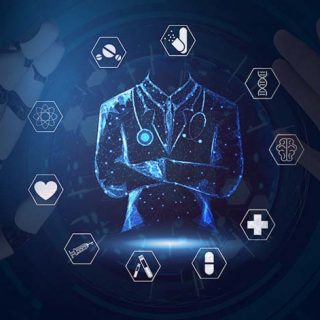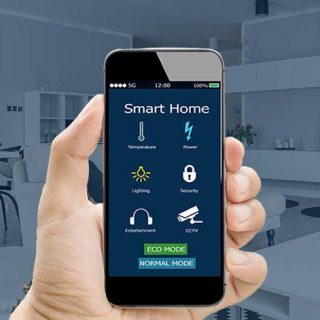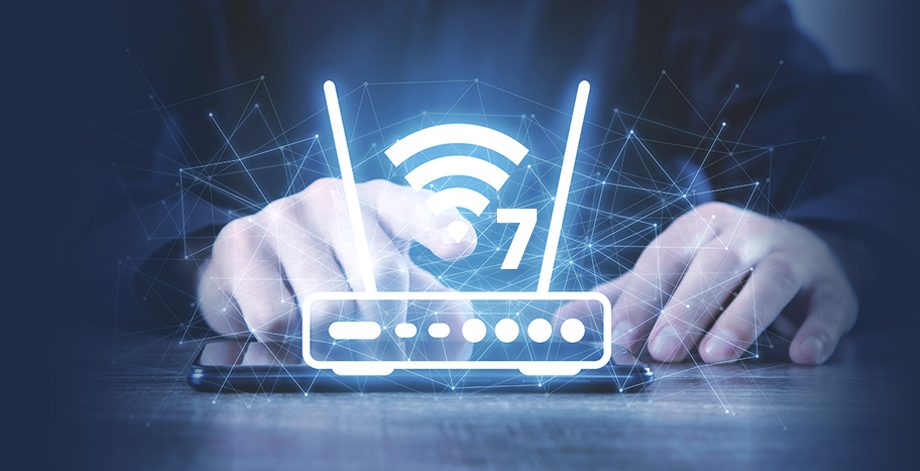Medical healthcare industry is known to be a slow adaptor of new technology application due to its fragmented and highly complex system. But in today’s era of the smart and connected world, medical healthcare world is all set to get transformed for delivering connected care solutions. As per the research healthcare in IoT will be spending approximately $1 trillion per year by 2025. There will be 25 to 50 billion connected devices by 2025, and healthcare will have a huge share in it. Thanks to Internet of Things (IoT) by monitoring health 24 hours a day, seven days a week, new technology should dramatically improve patient outcomes and convenience and shrink costs.
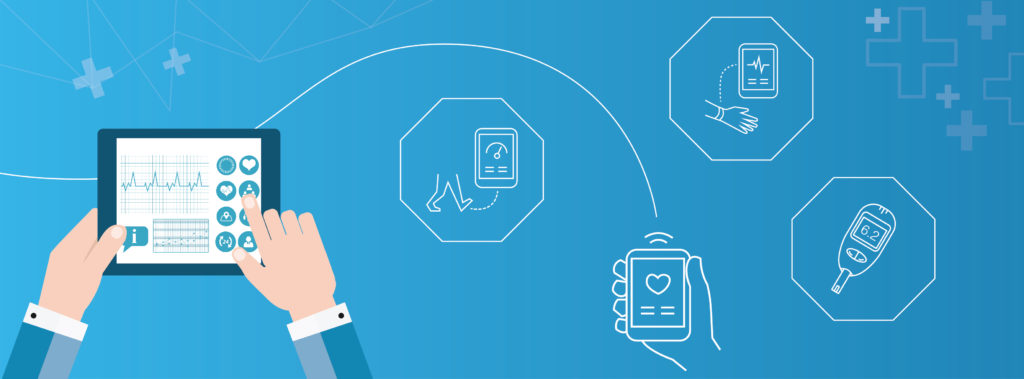
The main challenge for the designer is addressing the conflicting requirement of power and performance. Optimized power management and low power solution become a necessary consideration for medical wearable designs. This article highlights common ways medical wearables draws power, power-optimized design, and its implementation techniques.
- Common Ways Medical Wearable Devices Draw Power:
A medical wearable system is a group of subsystems which involves data collection, telemetry, analysis and alerting. Here are some common ways/scenarios medical wearable devices draw power:
- Sensors data are to be sampled continuously/frequently for monitoring of patient’s organs or actions
- Data transmission to mobile application or cloud requires (In a normal health situation, this will be once/twice a day) more amount of power
- In case of alert situation, quick and much frequent data transmission to monitoring facility draws excessive power
- Unavailability of Wi-Fi network / bluetooth enabled mobile device puts healthcare wearable device in the searching mode for predefined scan duration. During this period, device draws more power
- Complex algorithm (which normally takes more time to execute) to analyze patient’s body sensor data requires more amount of power
- Prioritize the Functionalities in the Case of Low Power Condition:
Continuous usage of battery operated medical wear and unavailability of charging facility on time may draw battery capacity below threshold limit which forces the device to be operated in low power mode. But still, some important core functionalities related to patient’s vital change or alert situation monitoring are required to be executed quickly. Wearables power management approach shall allow usage of increased power for such core functionalities. Here are few such examples:
- Wearables used to monitors patient’s cough/respiration/wheeze audio pattern to identify level of asthma are required to capture and analyze the audio continuously even in low power mode
- In case of abnormal situation/alert condition, data needs to be reported quickly to remote medical facility
- User shall be notified about the abnormal health condition using vibrator or display device
- In the case of connectivity with a monitoring device (cloud/mobile application) lost, abnormal health condition data needs to be stored in non-volatile memory before the battery drains completely. These data may be required for further analyses of the situation
- Architecture and Hardware Selection for Power Optimized Medical Wearable:
To help designers cope with the engineering challenges associated with medical wearables, manufacturers are offering System-on-Chip (SoC) solutions with a combination of power efficient microcontroller and application processor for complex data analysis/algorithm. One can also select both of them separately and interface them through communication bus (I2C/UART/SPI etc.) Peripherals required for continuous monitoring of patient’s health (i.e. Sensors attached to patient’s body) and wearable’s health (i.e. Fuel Gauge for Battery Monitoring) should be connected to the low power controller.
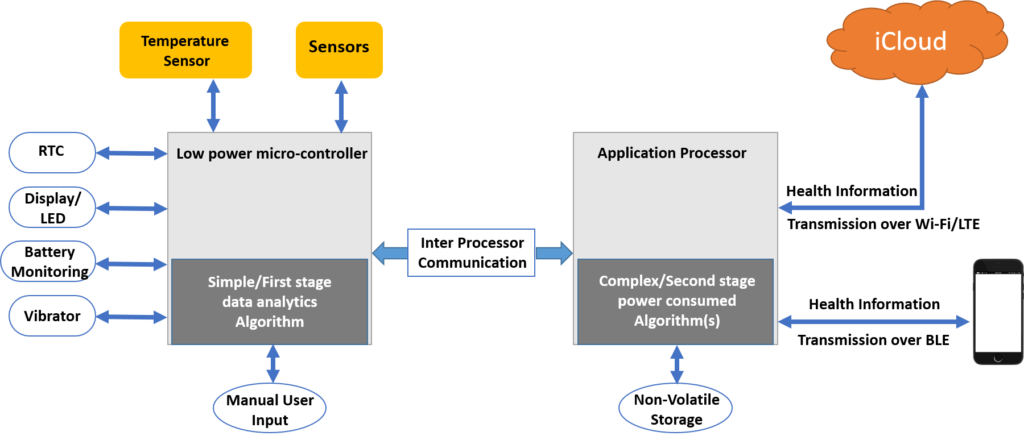
Hardware platform and component selection also play an important role for power-optimized medical wearable product design. Here are few points to be considered:
- Choose SoC, RAM, EEPROM, Connectivity peripherals (Wi-Fi, LTE, Bluetooth) etc. having support for low power operating modes and low power requirement. Refer datasheet and go through their power requirement before selection
- If possible, do enough feasibility using some off-the-shelf platform to measure actual power consumption
- Medical devices that travel with the patient are required to be designed considering the risk of being handled roughly and being exposed to extreme temperatures and moisture
- Calculate the memory requirement to store patient’s health data. Choose memory with low power requirement
- Design & Implementation Techniques for Power Optimized Wearable:
- Remove/disable unnecessary software services which are not being used for device operation
- Keep advanced power consumed processor in low power state most of the time. Use ultra-low power controller to continuous capturing of data and wake-up advance processor as and when required
- Bluetooth® Smart, or Bluetooth Low Energy, is automatically built into most new smartphones and thus is the standard for wireless communication for wearables
- Divide complex analysis algorithm into two steps. The first step would be simple algorithm running on low power controller which is being used to analyze the possibility of an abnormal condition. The second step would be complex algorithm running on advanced power consuming processor to confirm the abnormal situation
- Reduce data transmission frequency to remote monitoring facility in case of normal health condition
- Do not keep network scan duration timeout period long
- Disable non-critical functionalities in the case of low power mode operation of the device. i.e. firmware upgrade, device self-test, calibration etc.
- Disable unwanted peripherals clocks within SoC
- Define optimized data frame format to reduce data transmission payload from wearable device to mobile application/cloud server
- If possible, different actuators (like vibrators, LED or Display) being used to notify the patient about abnormal situation shall be connected with continuous ON ultra-low power mode controller to keep advanced processor in sleep mode during most of the time of device operation
- Conclusion:
Although in the coming era of mobile health and IoT in healthcare, there will be pivotal components including highly sensitive biosensors, low-power integrated electronic circuits, low-power and reliable wireless communication, and obviously a sufficient power source. As the recent advances in nanotechnology and materials have enabled the realization of smaller and more sensitive sensors consuming less energy as well as low-power and smaller sized electronics, the increasing dependence on communication and interaction with other devices and a mobile cloud requires much higher power to operate the new-generation devices.
While designing medical product, reliability, accuracy, and safety are important areas to keep in mind. But when we transform such medical product into the wearable segment, its battery life also becomes a very important factor to be taken into consideration. A similar solution has been created in a recent case study of VOLANSYS, where the customer has developed an algorithm to detect asthma and VOLANSYS has developed an end-to-end solution (including hardware, firmware, mobile application, cloud database and web application) and integrated customer’s asthma detection algorithm in it.

About the Author: Ashish Agraval
Ashish Agraval is an embedded professional at VOLANSYS with experience in architecting, designing & delivering the solutions for embedded products. Ashish has good exposure in latest technologies like connected healthcare wearable, Internet of Things etc.

